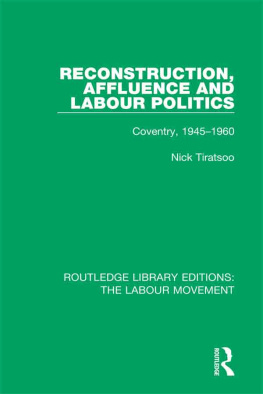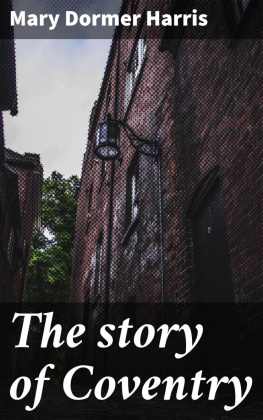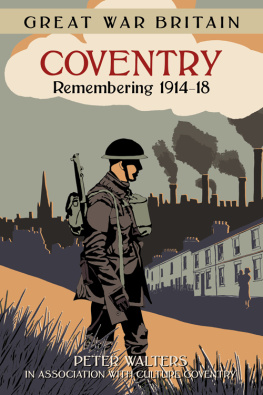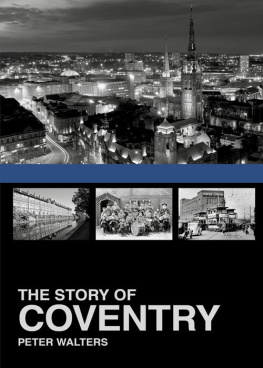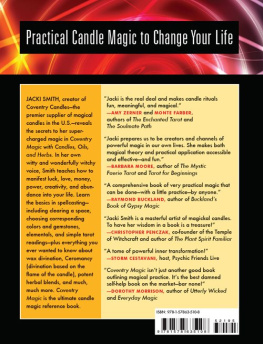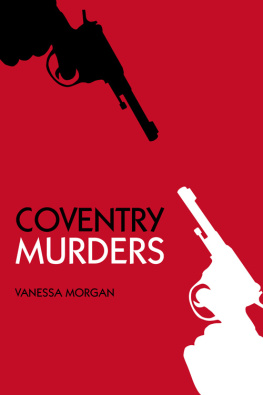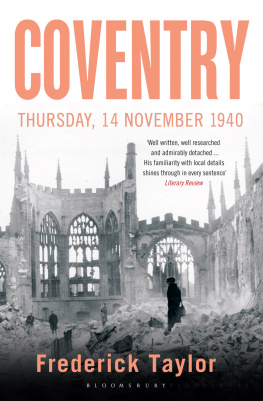ROUTLEDGE LIBRARY EDITIONS:
THE LABOUR MOVEMENT
Volume 41
RECONSTRUCTION,
AFFLUENCE AND
LABOUR POLITICS
RECONSTRUCTION,
AFFLUENCE AND
LABOUR POLITICS
Coventry, 19451960
NICK TIRATSOO
First published in 1990 by Routledge
This edition first published in 2019
by Routledge
2 Park Square, Milton Park, Abingdon, Oxon OX14 4RN
and by Routledge
711 Third Avenue, New York, NY 10017
Routledge is an imprint of the Taylor & Francis Group, an informa business
1990 Nick Tiratsoo
All rights reserved. No part of this book may be reprinted or reproduced or utilised in any form or by any electronic, mechanical, or other means, now known or hereafter invented, including photocopying and recording, or in any information storage or retrieval system, without permission in writing from the publishers.
Trademark notice: Product or corporate names may be trademarks or registered trademarks, and are used only for identification and explanation without intent to infringe.
British Library Cataloguing in Publication Data
A catalogue record for this book is available from the British Library
ISBN: 978-1-138-32435-0 (Set)
ISBN: 978-0-429-43443-3 (Set) (ebk)
ISBN: 978-1-138-32634-7 (Volume 41) (hbk)
ISBN: 978-0-429-44987-1 (Volume 41) (ebk)
Publishers Note
The publisher has gone to great lengths to ensure the quality of this reprint but points out that some imperfections in the original copies may be apparent.
Disclaimer
The publisher has made every effort to trace copyright holders and would welcome correspondence from those they have been unable to trace.
The Reconstruction of Coventry 19451960
Reconstruction, affluence and Labour politics:
Coventry 194560
N. Tiratsoo
London and New York
First published 1990
by Routledge
11 New Fetter Lane, London EC4P 4EE
Simultaneously published in the USA and Canada
by Routledge
a division of Routledge, Chapman and Hall, Inc.
29 West 35th Street, New York, NY 10001
1990 Nick Tiratsoo
Typeset in 10/12pt Times by
Megaron, Cardiff, Wales
Printed in Great Britain by
Biddles Ltd, Guildford, Surrey
All rights reserved. No part of this book may be reprinted or reproduced or utilised in any form or by any electronic, mechanical, or other means, now known or hereafter invented, including photocopying and recording, or in any information storage or retrieval system, without permission in writing from the publishers.
British Library Cataloguing in Publication Data
Tiratsoo, Nick
Reconstruction, affluence and Labour politics : Coventry, 19451960.
1. West Midlands (Metropolitan County). Coventry. Local government, history
I. Title II. Series
352.042498
ISBN 0-415-04877-X
Library of Congress Cataloging in Publication Data
Tiratsoo, Nick, 1952
Reconstruction, affluence and Labour politics: Coventry, 1945-1960 / Nick Tiratsoo.
p. cm.(Britain in the twentieth century)
ISBN 0-415-04877-X: $30.00
1. Coventry (England)Politics and government.
2. Coventry (England)Economic conditions.
3. Reconstruction (19391951)EnglandCoventry.
I. Title II. Series
DA690.C75T57 1990
942.498dc20
Contents
| Statistical Appendix |
| The population of Coventry County Borough, 193960 |
| The relative prosperity of Coventry in the 1930s: selected indicators |
| War damage in Coventry and other blitzed cities: selected indicators |
| Rateable value: Coventry and other blitzed cities, 193950 |
| Analysis of rateable property in Coventry, 1940, 1946, 1952 and 1960 |
| Rates in Coventry and other blitzed cities, 193940 to 195960 |
| Applications for Council houses and the Council waiting list, Coventry, 194460 |
| Houses built in Coventry, for the Corporation and for private sale, 194660 |
| Political Coventry: General Election results and percentage voting Labour, 194559; and municipal electorates, turnouts, results and percentage voting Labour, selected contests, 194559 |
| Political Coventry: percentage voting Labour by ward, selected municipal elections, 194759 |
The research on which this work is based was compiled during 19868 while I was Senior Research Fellow at the Centre for the Study of Social History, University of Warwick. I am indebted to the Volkswagenwerk Stiftung (which supported me financially), Professor D. Petzina and the staff of the Centre for making this opportunity possible. I would particularly like to thank Dr Tony Mason of the Centre for his kindness and intellectual advice during my years at Warwick.
Secondly, I would like to acknowledge with gratitude the considerable help I have received from various archivists, notably David Rimmer and the staff at the Coventry Record Office, Richard Storey and the staff at the Modern Records Centre, University of Warwick, and the librarians who deal with Local Studies at the Coventry City Library.
Thirdly, I am grateful to a number of organisations for permission to quote from their archives, and wish to record my particular appreciation of the privileges granted to me in this connection by, amongst others, Alvis, the British Motor Industry Heritage Trust, Coventry City Council, Coventry Labour Party, the Rolls-Royce Heritage Trust and A. H. Realisations Ltd.
Finally, I would like to thank all those individuals who have advised me on different aspects of post-war history especially Louise Campbell, Steve Fielding, John Gold, Richard Hyman, Junichi Hasegawa, David Thoms and Jim Tomlinson. I owe a more general debt to Pat Thane who gave encouragement and good counsel during the preparation of the manuscript.
Few places in Britain felt the impact of the Second World War as vividly or as consistently as Coventry. An important engineering centre, with a history of motor vehicle production, the city found itself from the first caught up in the armaments drive. Such specialisation in turn inevitably brought considerable attention from the German air force, with the raids of 1940 and 1941 destroying much of the urban areas inner core. The central aim of the chapters that follow is to describe how Coventry recovered from these experiences, and subsequently emerged in the 1950s not only as a nationally known boom town, but also as an exemplar of a new type of city, in tune with the demands of a modern, more democratic and equitable age. In particular, this means giving considerable attention to the plans and policies of Coventrys Labour party, since it was this body, using its continuing domination of the city Council, that was most involved in attempting to shape the various facets of reconstruction physical, social and economic. But emphasis will also be placed on the context within which this shaping took place, and on the incentives and constraints which encouraged or retarded the achievement of the Labour partys vision. Reference will be made, for example, to the web of connections which linked the city to the variety of interested government departments in London. On the other hand, it will also be necessary to explore Labours relationship with the local electorate, and especially the growing disenchantment with the party which began to threaten its dominance during the 1950s.

